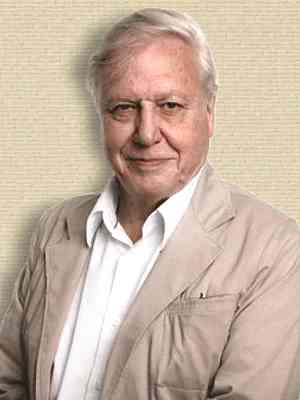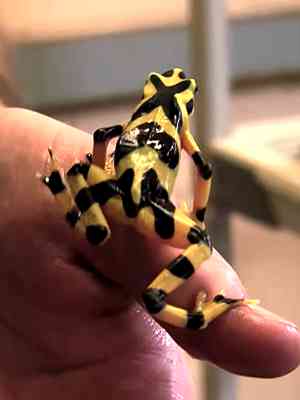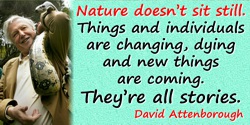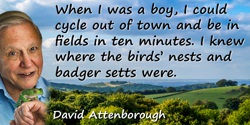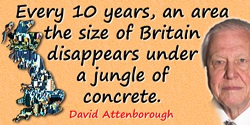 (source)
(source)
|
Sir David Attenborough
(8 May 1926 - )
English naturalist and broadcaster whose distinguished career in broadcasting spans more than a half-century. His Zoo Quest television series that began in 1952 ran for ten years, and was just the beginning of a life-long passion for presenting natural history television series from all parts of the world.
|
Life on Air: Memoirs of a Broadcaster
by David Attenborough
Excerpt from Chapter 29 — 'Completing the Set' (2009)
[This excerpt reads like a short story, complete in itself, about the Panamanian Golden Frog. The tiny amphibian was filmed in the wild on the brink of extinction in its natural habitat, due to a widely spreading fatal fungal disease. An interesting video sequence was captured, before the frog’s time in the wild finally ran out. It was included in the Life in Cold Blood BBC/Animal Planet TV documentary series. Yet, the species does live on because of concerted breeding efforts by various zoos. As for life in the wild, was the frog described here waving a last goodbye? This note, and the subtitle below, by Webmaster.]
[The Last Wave]
[p.402] In over fifty years of programme-making, I have never filmed an animal that has subsequently become totally extinct. We had made sequences about several species that are now extremely rare. In Life on Earth, I had sat with mountain gorillas, of which the world population had then numbered only a few hundred. During the series on birds, we had filmed the kakapo, a giant flightless parrot that at one time had been reduced to seven individuals of which only two were females. In each case, thankfully, devoted conservationists had managed to bring the species back from the very brink of extinction. But for Cold Blood, we filmed a species that by the time the series was transmitted had almost certainly disappeared entirely from the wild.
It is a tiny frog, smaller than my thumb, known scientifically as Atelopus ziteki, that once lived in a small patch of rain forest in Panama. In colour it is a beautiful almost luminous gold, spotted with a few variable blotches of black. Traditionally, it was revered as sacred by local people. In centuries past, they made images of it in gold and wore them as talismans. In modern times, living specimens have been collected intensively and sold for high prices to the pet trade. That and the steady destruction of its wild habitat has meant that it has become increasingly and dangerously reduced in numbers.
We were interested in it, not just because of its rarity but because it had a most engaging way of signalling. It lives on the banks of small swiftly running streams. Most frogs, of course, in the breeding season communicate by croaking. But that is not always effective for the golden frog because the sound of rushing water in a nearby stream may make its voice inaudible. So it reinforces its rather feeble calls with gestures. It makes a slow jaunty wave with one of its front legs, rather like a dandy expressing his good humour by touching the brim of his hat.
But frogs all over the world, in recent years, have been afflicted by a fungi that infects their moist skin. Although frogs do have lungs, they also breathe through their skins. The fungus, as it spreads over their bodies, eventually [p.403] prevents them from doing so and they die from suffocation. The advance of this fungal disease across Australia, Africa and South America has been recorded in detail. When we started filming Cold Blood, it was moving along the Isthmus of Panama steadily and inexorably. No antidote, no spray, has been discovered that can stop it. At the rate it was travelling, it would reach the golden frog’s territory in 2007. The decision had therefore been taken by conservation scientists to marshal all available local help and collect every golden frog they could find. They could then be taken to zoos in Panama and elsewhere, where they could be kept and bred in captivity until such time that either a cure can be found for the disease or the fungus has disappeared in the wild for want of hosts—if, in fact, either of these two things ever happens. In captivity, however, the frogs do not wave to one another as they do in the wild. So if we wanted to record that behaviour, we had only one season in which to do it.
We were guided to the last area where the species could reliably be found by Erik Lindquist*, a biologist who has studied the species for many years. It was he who had worked out the details of the species’ gestural language. To do so he had used a small but accurate model of one attached to the end of a long pole with which he could make it move its front legs in just the way a live one does. With that we were able to persuade one of the frogs to make its last wave before Erik and his team collected it and took it away to safety.
- Science Quotes by Sir David Attenborough.
- 8 May - short biography, births, deaths and events on date of Attenborough's birth.
- David Attenborough - TV Debut on Zoo Quest (21 Dec 1954)
- Life on Air: Memoirs of a Broadcaster, by David Attenborough. - book suggestion.
- Booklist for David Attenborough.
